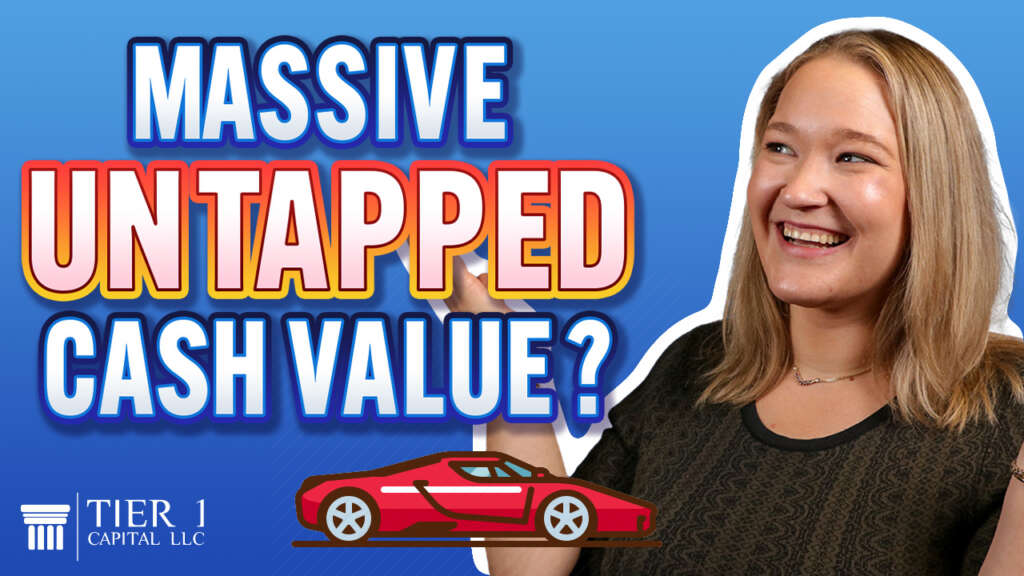
Do you have a Ferrari in your garage, and you’ve never driven it? Someone recently reached out and they had a 12-year-old life insurance policy sitting doing nothing. This means they had cash value in the policy that’s accumulated over the last 12 years, and they’ve never put that money and deployed it in their financial system before. So we were able to create a plan for them to get out of debt.
You’ll hear us talk often about specially designed whole life insurance policies designed for cash accumulation. However, all life insurance policies have a cash value aspect built into the cake. You see, when you have a whole life insurance policy the insurance company is making two promises. The first is to pay the death benefit when the insured dies, as long as that policy is in force. The second is to have a cash value equal to the death benefit at the age of maturity, which is typically age 100 or 121. In order to keep that second promise, the insurance company is required to stash away more and more cash over time.
Now, the policy owners have something called a loan provision built into their contract, which guarantees them access to that cash value via policy loans. You see, these people bought their original policies for death benefit purposes, but they also had the cash accumulation.
Now, the policies were 12 years old. They were very well seasoned, meaning that at this stage of the game, the cash value increase was over $2 for every dollar they paid in premium. That was a really good moneymaking machine, so to speak. And I explained to them, it’s sort of like you have a Ferrari in your garage and you’ve never taken it out on the street. We’re going to give you the keys to that Ferrari so you can get it working for you, not the insurance company.
You see that policy has that cash value that you’re able to access through the loan provision on a guaranteed basis. You’re able to repay it within your cash flow because it’s an unstructured loan from the insurance company. And what this family is able to do is borrow against their cash value and pay off this high-interest credit card.
Now, the key here is that as they repay that policy loan, it’s going to reduce the lien against their cash value and they’ll have access to more and more cash value over time. With that, they’ll be able to pay off all of their credit card debt using this process. The beautiful part about it is that they’re going to get out of debt quicker than if they put all of their payments and snowball them on one credit card, then the next, then the next.
That’s the amazing thing about this. Because now they’re filling up that policy equity with two hoses, the premium hose, and the loan repayment hose. Before they were only filling it with the premium hose and they weren’t even tapping into it.
You see, there’s a big difference between paying off debt with a regular snowball and just putting all your cash flow towards getting out of debt as soon as possible versus using a policy loan. Because if you just snowball the traditional way, you spend all of your money and send it all off to the credit card companies, and at the end of the day, what do you have to show for it? Nothing. A zero debt balance.
However, when you use the policy loan to get out of debt, at the end of the day, you have a policy full of cash value that you’re able to access and leverage again, so you are less dependent on those credit companies in the future when it comes to finance your next purchase.
Another key distinction between policy loans and traditional debt is that there’s no qualification. It doesn’t impact your credit score. So actually, their credit score is probably going up after they pay off that credit card debt. And it’s an unstructured repayment schedule so that they’re able to fit the payments into their cash flow.
If they’re feeling cash flush and have a lot of extra cash flow, they can put extra towards that policy loan and get it paid off and built up faster. But if they’re feeling pinched and they only want to make a small amount, they have the flexibility to do that with no questions asked. Because the entity that is guaranteeing that debt is the insurance company, and coincidentally, the insurance company is also the one who’s lending the money to the insured.
And here’s a better distinction when they made the credit card debt, they had to actually apply for the credit card and get permission for that lending amount. They were applying for permission from the bank or the credit company to give them a revolving line of credit. When they went to get the policy loan they were giving an order. They were literally telling them, This is what I want, go get it for me. That is not a small distinction.
The bottom line is, would you rather be controlled by the process or be in control of the process? Do you have a life insurance policy just sitting around doing nothing while you’re accumulating debt?
If that sounds like you, hop right on our calendar by clicking the Schedule your Free Strategy Session button. We’d be happy to talk to you about your situation and how to get you on the path to financial freedom.
And remember, it’s not how much money you make, it’s how much money you keep that really matters.
